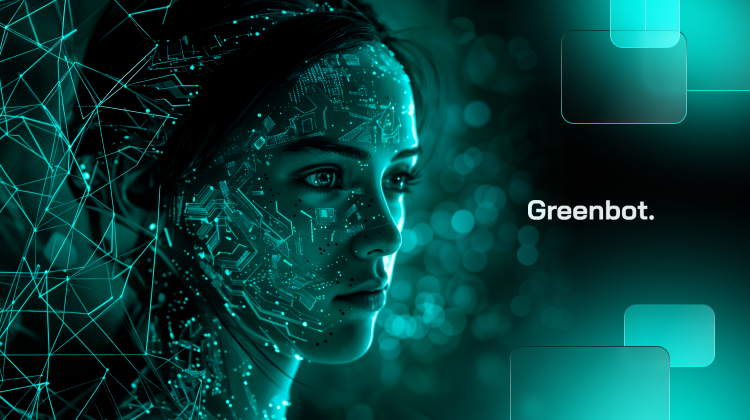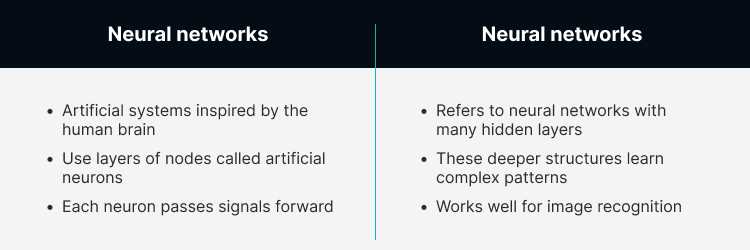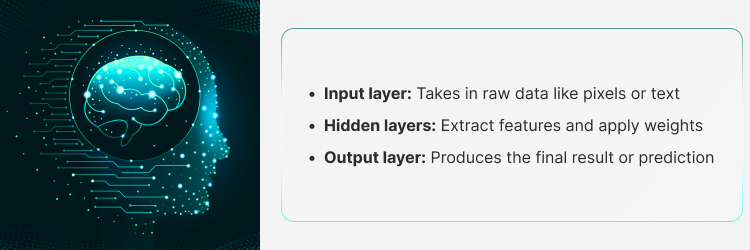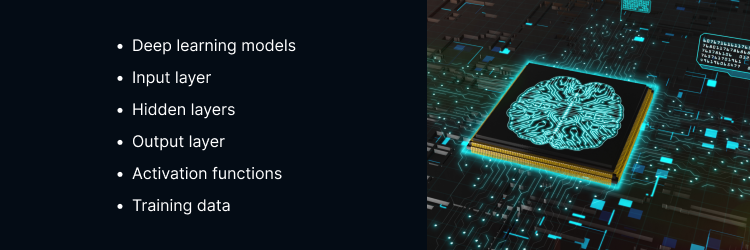
Neural networks and deep learning are at the core of modern artificial intelligence. These systems mimic how the human brain works—helping machines learn from data, spot patterns, and make smart decisions.
They power everyday tools. Think speech recognition, image analysis, and personalized recommendations.
As part of machine learning, neural networks and deep learning help solve complex tasks with speed and accuracy. They’re the reason AI can understand language, recognize faces, and recommend what you’ll watch next.
In this article, you’ll learn what neural networks and deep learning are, how they work, and why they matter in today’s AI-driven world. You’ll also see how deep learning, with its multi-layered algorithms, fits into the broader structure of AI and machine learning.
Let’s dive into it.
What Are Neural Networks and Deep Learning?

A simple neural network consists of a single hidden layer, where each node in one layer is fully connected to every node in the subsequent layer. In contrast, deep learning systems contain multiple hidden layers, highlighting the differences in complexity between simple and deep networks.
A neural network has three parts:
- Input layer
- Hidden layers
- Output layer
Each neuron passes signals forward after simple calculations.
Deep learning refers to neural networks with many hidden layers. The “deep” in deep learning means extra layers between input and output. These deeper structures learn complex patterns from huge training data sets. That’s why deep learning works well for image recognition and language translation.
Both neural networks and deep learning are subfields of machine learning — a branch of AI that trains computers to learn from data and make predictions without being explicitly programmed.
Difference Between Deep Learning and Neural Networks
Neural networks are the base of many AI systems.
Deep learning refers to advanced systems that use deep neural networks—meaning more hidden layers—to solve complex tasks.
This extra depth helps deep learning systems find patterns standard neural networks may miss.
Architecture
A neural network may have just one or two hidden layers. A hidden layer is crucial as it allows the network to learn complex patterns by transforming input data into a more useful form. A deep learning system includes many hidden layers—making the model “deep.” This layered design improves pattern recognition and decision-making.
CNN Architecture
Basic neural networks rarely use convolutional layers. Deep neural networks use CNNs for tasks like image recognition and video analysis. These layers scan data in small pieces, detecting patterns like edges or colors.
RNN Architecture
Standard neural networks can use loops but are limited. Deep learning systems use RNNs to manage sequences, such as speech and text. These loops help retain context across time steps.
Complexity
Neural networks are simpler. They’re faster to train and easier to interpret. Deep learning systems are more complex, with millions of parameters that require high compute power.
Training
Neural networks need less data and compute. They can train on basic hardware. Deep neural networks require large datasets, longer training, and GPUs to perform well.
Performance
Neural networks work well on basic tasks. But they’re limited by shallow depth. Deep learning systems shine in complex tasks like speech recognition, language processing, and image recognition.
How Neural Networks Work

Neural networks—also known as artificial neural networks—process data through layers of connected nodes. Each layer transforms input into output step by step.
- Input layer: Takes in raw data like pixels or text
- Hidden layers: Extract features and apply weights
- Output layer: Produces the final result or prediction
Generative modeling is used in deep learning systems for tasks like anomaly detection and data compression, showcasing the advanced capabilities of these models.
Each neuron uses activation functions like ReLU or sigmoid. These add non-linearity, helping the network process data more effectively.
During training, the model adjusts weights to reduce errors. With each pass, it improves prediction accuracy.
This structure allows neural networks to handle tasks like classification, pattern detection, and language understanding.
Deep Neural Networks: Why the Depth Matters
Deep neural networks handle complex tasks better than shallow ones. Their many hidden layers allow for step-by-step learning—from simple features to high-level patterns.
Early layers detect lines or textures. Deeper layers combine them into shapes, faces, or objects.
This layered structure helps a deep network learn from huge data points and generalize better.
Most deep neural networks outperform simpler models by capturing deeper, more abstract relationships in data.
What Is the Difference Between AI, ML, and DL?
Artificial intelligence, machine learning, and deep learning are part of the same hierarchy—but they aren’t the same thing.
- Artificial intelligence (AI): AI is the broad idea of machines acting like humans. Example: A voice assistant answering questions.
- Machine learning (ML): ML is a type of AI that learns from data using machine learning algorithms. Example: Email apps that learn to filter spam.
- Deep learning (DL): DL is a type of ML that uses layered neural networks. Example: A face recognition system trained on millions of images.
Difference Between Deep Learning and Machine Learning
Deep learning systems don’t need manual feature selection. They learn patterns directly from raw data.
Machine learning still relies on human-tuned features. It performs well on small, structured datasets.
Deep learning works best on large, unstructured data. It handles complex tasks like speech and image recognition without human help.
This is how deep learning makes data processing faster and more powerful than traditional machine learning.
Key Components of Deep Learning Systems

Deep learning systems rely on a few core parts to function:
- Deep learning models: Built as layered neural networks for solving hard problems
- Input layer: Takes in raw data (images, text, etc.)
- Hidden layers: Extract patterns using weighted links
- Output layer: Gives the final result or classification
- Activation functions: Add non-linearity (e.g., ReLU, sigmoid) to learn complex patterns
- Training data: Large, often labeled, datasets needed to train deep models
These parts work together to help deep learning systems learn, predict, and improve.
Types of Neural Networks
Deep learning networks come in different types, each with a unique role:
- Feedforward neural networks (FNNs): The simplest type. Data moves one way—from input to output. Common in pattern recognition and basic classification tasks.
- Convolutional neural networks (CNNs): Designed for image and video analysis. Use filters to detect textures, shapes, and edges. Often used in image recognition and medical imaging.
- Recurrent neural networks (RNNs): Handle sequences like speech and text. Built with loops to carry context between steps. Great for language modeling, speech recognition, and translation.
Why Deep Learning Requires More Data
Deep learning refers to systems that learn patterns from raw data. They don’t rely on handcrafted features like classic machine learning.
Because of their deep architectures, they need millions of data points to learn well.
More training data improves accuracy and reduces overfitting. That’s why deep learning is powerful—but also very data-hungry.
Benefits and Challenges of Deep Learning
Pros:
- Learns patterns directly from raw data
- Handles complex tasks like speech and image recognition
- Improves with larger datasets
- Reduces the need for manual tuning
Cons:
- Needs a lot of training data and computing power
- Can be slow to train
- Results are often hard to explain compared to traditional machine learning
FAQs About Neural Networks and Deep Learning
What is neural network and deep learning?
Neural networks are AI models made of connected nodes that process data.
Deep learning is a branch of machine learning that uses neural networks with many layers to solve complex problems.
What are the 3 types of learning in neural networks?
- Supervised Learning: Uses labeled data (e.g., classification).
- Unsupervised Learning: Finds patterns in unlabeled data (e.g., clustering).
- Reinforcement Learning: Learns via rewards/penalties (e.g., game AI).
What’s the difference between deep learning and neural networks?
Neural networks are the foundational deep learning algorithms, while deep learning uses deep neural networks (networks with multiple layers) to handle more complex tasks. Essentially, deep learning is a subset of machine learning that utilizes deep neural network architectures.
How deep learning differs from machine learning?
ML often requires manual feature extraction and works well with smaller datasets. Deep learning automates feature extraction and performs better on complex tasks using large amounts of data and computing power.
What is the difference between AI and ML and DL?
- AI: Broad field of intelligent machines.
- ML: AI subset where systems learn from data.
- DL: Advanced ML using deep neural networks.
Final Thoughts on Neural Networks and Deep Learning
Neural networks and deep learning power many everyday tools—from voice assistants to content recommendations. These systems, built on layers of artificial neurons, now drive major advances in computer vision, natural language processing, and other areas of computer science.
With deep learning algorithms improving how machines understand data, the impact on machine learning continues to grow. From simple feedforward neural networks to complex models, deep learning is opening new frontiers in AI. There’s always more to learn in this fast-moving field.























